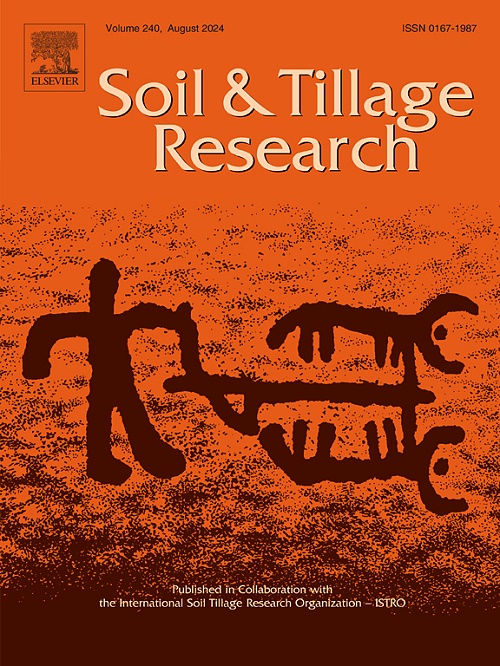Physico-chemical, microstructure, mechanical properties, and mechanism of dispersive saline soil treated with nano-silica sol
IF 6.8
1区 农林科学
Q1 SOIL SCIENCE
引用次数: 0
Abstract
Rapid disintegration and loss of structural stability characterizes dispersive soils in contact with water and are the cause of many engineering disasters. However, the use of traditional soil chemical additives suffers from environmental pollution, difficulty in sustainability, soil sclerosis and higher alkalinity. Therefore, this paper proposes the use of environmentally friendly materials nano-silica sol to reduce the exchangeable sodium ion (Na+) content and cement soil particles in order to modify dispersive soil. Prepare experimental samples by thoroughly mixing nano-silica sol with dispersive saline soil at a mass ratio of 0.5–5 %. Using unconfined compressive strength (UCS) and direct shear test (DST), pinhole and crumb tests, Atterberg and particle size analysis tests, scanning electron microscopy (SEM), X-ray diffraction (XRD), and Fourier transform infrared spectroscopy (FTIR) to investigate the mechanical properties, dispersion, physico-chemical properties, and microstructure of the treated soil. Results showed that nano-silica sol can effectively improve the mechanical properties and dispersibility of dispersive saline soil. When the nano-silica sol content was 5 %, the UCS of the treated soil was 416.97 kPa, and the cohesion was 46.03 kPa, compared to 66.97 kPa and 21.29 kPa for untreated soil, the UCS and cohesion increased by 523 % and 116 %. Additionally, at the optimal content of 2.5 %, the pH and Na+ concentration of the pore water solution in the treated soil decreased from 8.2 and 8.80 mmol/L in the untreated soil to 7.0 and 6.26 mmol/L, and the soil dispersion completely disappeared. SEM, XRD, and FTIR indicated that the calcium silicate hydrate (C-S-H) generated by the reaction in the treated soil cemented the soil particles. At the same time, when the silica sol content exceeded 2.5 %, a large amount of amorphous silica gel filled the soil pores. Both processes improved the microstructure of the soil and enhanced its mechanical properties. This research provides deeper insights into the application of nano-silica sol in soil improvement and the sustainable management of dispersive saline soils.
纳米硅溶胶处理分散性盐渍土的理化、微观结构、力学特性及机理
与水接触的分散土具有快速崩解和结构稳定性丧失的特点,是许多工程灾害的原因。然而,传统土壤化学添加剂的使用存在环境污染、可持续性差、土壤硬化、碱度高等问题。因此,本文提出使用环保材料纳米硅溶胶,降低交换性钠离子(Na+)含量和水泥土颗粒,以改性分散性土壤。纳米硅溶胶与分散的盐渍土以0.5-5 %的质量比充分混合,制备实验样品。采用无侧限抗压强度(UCS)和直剪试验(DST)、针孔和碎屑试验、Atterberg和粒度分析试验、扫描电子显微镜(SEM)、x射线衍射(XRD)和傅里叶变换红外光谱(FTIR)对处理后土壤的力学特性、分散性、理化特性和微观结构进行了研究。结果表明,纳米硅溶胶能有效改善分散性盐渍土的力学性能和分散性。当纳米硅溶胶含量为5 %时,处理土的单抗强度为416.97 kPa,黏聚力为46.03 kPa,而未处理土的单抗强度为66.97 kPa,黏聚力为21.29 kPa,单抗强度和黏聚力分别提高523 %和116 %。此外,在最佳含量为2.5 %时,处理土壤孔隙水溶液pH和Na+浓度由未处理土壤的8.2和8.80 mmol/L降至7.0和6.26 mmol/L,土壤分散完全消失。SEM、XRD和FTIR分析表明,处理后土壤中反应生成的水合硅酸钙(C-S-H)黏结了土壤颗粒。同时,当硅溶胶含量超过2.5 %时,大量无定形硅胶填充土壤孔隙。这两种处理都改善了土的微观结构,增强了土的力学性能。本研究为纳米硅溶胶在土壤改良和分散盐渍土可持续管理中的应用提供了更深入的见解。
本文章由计算机程序翻译,如有差异,请以英文原文为准。
求助全文
约1分钟内获得全文
求助全文
来源期刊

Soil & Tillage Research
农林科学-土壤科学
CiteScore
13.00
自引率
6.20%
发文量
266
审稿时长
5 months
期刊介绍:
Soil & Tillage Research examines the physical, chemical and biological changes in the soil caused by tillage and field traffic. Manuscripts will be considered on aspects of soil science, physics, technology, mechanization and applied engineering for a sustainable balance among productivity, environmental quality and profitability. The following are examples of suitable topics within the scope of the journal of Soil and Tillage Research:
The agricultural and biosystems engineering associated with tillage (including no-tillage, reduced-tillage and direct drilling), irrigation and drainage, crops and crop rotations, fertilization, rehabilitation of mine spoils and processes used to modify soils. Soil change effects on establishment and yield of crops, growth of plants and roots, structure and erosion of soil, cycling of carbon and nutrients, greenhouse gas emissions, leaching, runoff and other processes that affect environmental quality. Characterization or modeling of tillage and field traffic responses, soil, climate, or topographic effects, soil deformation processes, tillage tools, traction devices, energy requirements, economics, surface and subsurface water quality effects, tillage effects on weed, pest and disease control, and their interactions.
 求助内容:
求助内容: 应助结果提醒方式:
应助结果提醒方式:


